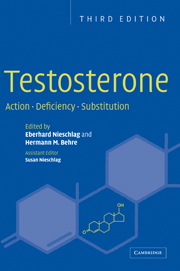Book contents
- Frontmatter
- Contents
- List of contributors
- Preface
- 1 Testosterone: an overview of biosynthesis, transport, metabolism and non-genomic actions
- 2 The androgen receptor: molecular biology
- 3 Androgen receptor: pathophysiology
- 4 Behavioural correlates of testosterone
- 5 The role of testosterone in spermatogenesis
- 6 Androgens and hair: a biological paradox
- 7 Androgens and bone metabolism
- 8 Testosterone effects on the skeletal muscle
- 9 Androgens and erythropoiesis
- 10 Testosterone and cardiovascular diseases
- 11 Testosterone and erection
- 12 Testosterone and the prostate
- 13 Clinical uses of testosterone in hypogonadism and other conditions
- 14 Pharmacology of testosterone preparations
- 15 Androgen therapy in non-gonadal disease
- 16 Androgens in male senescence
- 17 The pathobiology of androgens in women
- 18 Clinical use of 5α-reductase inhibitors
- 19 Dehydroepiandrosterone (DHEA) and androstenedione
- 20 Selective androgen receptor modulators (SARMs)
- 21 Methodology for measuring testosterone, DHT and SHBG in a clinical setting
- 22 Synthesis and pharmacological profiling of new orally active steroidal androgens
- 23 Hormonal male contraception: the essential role of testosterone
- 24 Abuse of androgens and detection of illegal use
- Subject Index
22 - Synthesis and pharmacological profiling of new orally active steroidal androgens
Published online by Cambridge University Press: 18 January 2010
- Frontmatter
- Contents
- List of contributors
- Preface
- 1 Testosterone: an overview of biosynthesis, transport, metabolism and non-genomic actions
- 2 The androgen receptor: molecular biology
- 3 Androgen receptor: pathophysiology
- 4 Behavioural correlates of testosterone
- 5 The role of testosterone in spermatogenesis
- 6 Androgens and hair: a biological paradox
- 7 Androgens and bone metabolism
- 8 Testosterone effects on the skeletal muscle
- 9 Androgens and erythropoiesis
- 10 Testosterone and cardiovascular diseases
- 11 Testosterone and erection
- 12 Testosterone and the prostate
- 13 Clinical uses of testosterone in hypogonadism and other conditions
- 14 Pharmacology of testosterone preparations
- 15 Androgen therapy in non-gonadal disease
- 16 Androgens in male senescence
- 17 The pathobiology of androgens in women
- 18 Clinical use of 5α-reductase inhibitors
- 19 Dehydroepiandrosterone (DHEA) and androstenedione
- 20 Selective androgen receptor modulators (SARMs)
- 21 Methodology for measuring testosterone, DHT and SHBG in a clinical setting
- 22 Synthesis and pharmacological profiling of new orally active steroidal androgens
- 23 Hormonal male contraception: the essential role of testosterone
- 24 Abuse of androgens and detection of illegal use
- Subject Index
Summary
Introduction
There is a general need for new orally active androgens, to be used for androgen replacement therapy and male hormonal contraception. As a substitute for low levels of testosterone in hypogonadal men, therapy with the natural androgen testosterone is the first choice. However, testosterone is an androgen with a relatively low affinity for the androgen receptor. It is metabolically relatively unstable which results in poor oral bioavailability. In addition, testosterone is converted by 5α-reductase into the more potent androgen 5α-dihydrotestosterone (5α-DHT). Early attempts to prevent metabolic instability by 17α-alkylation of androgens (like introduction of 17 α-ethynyl in estrogens and progestagens) were not successful, due to liver toxicity or low androgenic activity (Vida 1969). Another approach to circumvent metabolic instability is esterification of the 17β-OH group of testosterone with long chain fatty acids. Testosterone undecanoate formulated in an oily solution (Andriol®/Andriol TestocapsTM, dissolved in oleic acid and a mixture of castor oil and polypropylene glycol laurate, respectively) is currently the only orally active testosterone derivative. This testosterone ester is hydrolysed by tissue (liver) esterases and testosterone is released (Bursi et al. 2001). However, due to the limited potency of testosterone and limited bioavailability of testosterone undecanoate, relative high doses of Andriol®/Andriol TestocapsTM are required twice a day for human androgen replacement (total dose 160–240 mg).
Although no side effects of testosterone replacement on the prostate have been reported, androgens which are not potentiated upon 5α-reduction in the prostate and skin, like 7α-methyl-19-nortestosterone (MENT) and 19-nortestosterone (nandrolone), are considered prostate-safe androgens (Kumar et al. 1992; Cummings et al. 1998).
- Type
- Chapter
- Information
- TestosteroneAction, Deficiency, Substitution, pp. 665 - 684Publisher: Cambridge University PressPrint publication year: 2004

